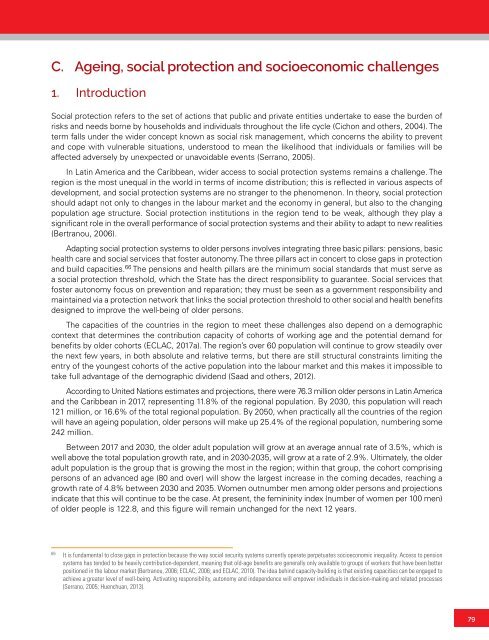Draft first regional report on the implementation of the Montevideo Consensus on Population and Development
This draft report seeks to give an account of progress in the implementation of the priority measures of the Montevideo Consensus on Population and Development in the region, as well as the differences between countries in terms of the degree of implementation. By highlighting relevant national experiences, it also seeks to facilitate the exchange of good practices among countries so that they can benefit from each other in their efforts to advance the implementation of the actions of the Montevideo Consensus.
This draft report seeks to give an account of progress in the implementation of the priority measures of the Montevideo Consensus on Population and Development in the region, as well as the differences between countries in terms of the degree of implementation. By highlighting relevant national experiences, it also seeks to facilitate the exchange of good practices among countries so that they can benefit from each other in their efforts to advance the implementation of the actions of the Montevideo Consensus.
Create successful ePaper yourself
Turn your PDF publications into a flip-book with our unique Google optimized e-Paper software.
<str<strong>on</strong>g>Draft</str<strong>on</strong>g> <str<strong>on</strong>g>first</str<strong>on</strong>g> <str<strong>on</strong>g>regi<strong>on</strong>al</str<strong>on</strong>g> <str<strong>on</strong>g>report</str<strong>on</strong>g> <strong>on</strong> <strong>the</strong> implementati<strong>on</strong> <strong>of</strong> <strong>the</strong> M<strong>on</strong>tevideo C<strong>on</strong>sensus <strong>on</strong> Populati<strong>on</strong> <strong>and</strong> <strong>Development</strong><br />
Chapter III<br />
C. Ageing, social protecti<strong>on</strong> <strong>and</strong> socioec<strong>on</strong>omic challenges<br />
1. Introducti<strong>on</strong><br />
Social protecti<strong>on</strong> refers to <strong>the</strong> set <strong>of</strong> acti<strong>on</strong>s that public <strong>and</strong> private entities undertake to ease <strong>the</strong> burden <strong>of</strong><br />
risks <strong>and</strong> needs borne by households <strong>and</strong> individuals throughout <strong>the</strong> life cycle (Cich<strong>on</strong> <strong>and</strong> o<strong>the</strong>rs, 2004). The<br />
term falls under <strong>the</strong> wider c<strong>on</strong>cept known as social risk management, which c<strong>on</strong>cerns <strong>the</strong> ability to prevent<br />
<strong>and</strong> cope with vulnerable situati<strong>on</strong>s, understood to mean <strong>the</strong> likelihood that individuals or families will be<br />
affected adversely by unexpected or unavoidable events (Serrano, 2005).<br />
In Latin America <strong>and</strong> <strong>the</strong> Caribbean, wider access to social protecti<strong>on</strong> systems remains a challenge. The<br />
regi<strong>on</strong> is <strong>the</strong> most unequal in <strong>the</strong> world in terms <strong>of</strong> income distributi<strong>on</strong>; this is reflected in various aspects <strong>of</strong><br />
development, <strong>and</strong> social protecti<strong>on</strong> systems are no stranger to <strong>the</strong> phenomen<strong>on</strong>. In <strong>the</strong>ory, social protecti<strong>on</strong><br />
should adapt not <strong>on</strong>ly to changes in <strong>the</strong> labour market <strong>and</strong> <strong>the</strong> ec<strong>on</strong>omy in general, but also to <strong>the</strong> changing<br />
populati<strong>on</strong> age structure. Social protecti<strong>on</strong> instituti<strong>on</strong>s in <strong>the</strong> regi<strong>on</strong> tend to be weak, although <strong>the</strong>y play a<br />
significant role in <strong>the</strong> overall performance <strong>of</strong> social protecti<strong>on</strong> systems <strong>and</strong> <strong>the</strong>ir ability to adapt to new realities<br />
(Bertranou, 2006).<br />
Adapting social protecti<strong>on</strong> systems to older pers<strong>on</strong>s involves integrating three basic pillars: pensi<strong>on</strong>s, basic<br />
health care <strong>and</strong> social services that foster aut<strong>on</strong>omy. The three pillars act in c<strong>on</strong>cert to close gaps in protecti<strong>on</strong><br />
<strong>and</strong> build capacities. 66 The pensi<strong>on</strong>s <strong>and</strong> health pillars are <strong>the</strong> minimum social st<strong>and</strong>ards that must serve as<br />
a social protecti<strong>on</strong> threshold, which <strong>the</strong> State has <strong>the</strong> direct resp<strong>on</strong>sibility to guarantee. Social services that<br />
foster aut<strong>on</strong>omy focus <strong>on</strong> preventi<strong>on</strong> <strong>and</strong> reparati<strong>on</strong>; <strong>the</strong>y must be seen as a government resp<strong>on</strong>sibility <strong>and</strong><br />
maintained via a protecti<strong>on</strong> network that links <strong>the</strong> social protecti<strong>on</strong> threshold to o<strong>the</strong>r social <strong>and</strong> health benefits<br />
designed to improve <strong>the</strong> well-being <strong>of</strong> older pers<strong>on</strong>s.<br />
The capacities <strong>of</strong> <strong>the</strong> countries in <strong>the</strong> regi<strong>on</strong> to meet <strong>the</strong>se challenges also depend <strong>on</strong> a demographic<br />
c<strong>on</strong>text that determines <strong>the</strong> c<strong>on</strong>tributi<strong>on</strong> capacity <strong>of</strong> cohorts <strong>of</strong> working age <strong>and</strong> <strong>the</strong> potential dem<strong>and</strong> for<br />
benefits by older cohorts (ECLAC, 2017a). The regi<strong>on</strong>’s over 60 populati<strong>on</strong> will c<strong>on</strong>tinue to grow steadily over<br />
<strong>the</strong> next few years, in both absolute <strong>and</strong> relative terms, but <strong>the</strong>re are still structural c<strong>on</strong>straints limiting <strong>the</strong><br />
entry <strong>of</strong> <strong>the</strong> youngest cohorts <strong>of</strong> <strong>the</strong> active populati<strong>on</strong> into <strong>the</strong> labour market <strong>and</strong> this makes it impossible to<br />
take full advantage <strong>of</strong> <strong>the</strong> demographic dividend (Saad <strong>and</strong> o<strong>the</strong>rs, 2012).<br />
According to United Nati<strong>on</strong>s estimates <strong>and</strong> projecti<strong>on</strong>s, <strong>the</strong>re were 76.3 milli<strong>on</strong> older pers<strong>on</strong>s in Latin America<br />
<strong>and</strong> <strong>the</strong> Caribbean in 2017, representing 11.8% <strong>of</strong> <strong>the</strong> <str<strong>on</strong>g>regi<strong>on</strong>al</str<strong>on</strong>g> populati<strong>on</strong>. By 2030, this populati<strong>on</strong> will reach<br />
121 milli<strong>on</strong>, or 16.6% <strong>of</strong> <strong>the</strong> total <str<strong>on</strong>g>regi<strong>on</strong>al</str<strong>on</strong>g> populati<strong>on</strong>. By 2050, when practically all <strong>the</strong> countries <strong>of</strong> <strong>the</strong> regi<strong>on</strong><br />
will have an ageing populati<strong>on</strong>, older pers<strong>on</strong>s will make up 25.4% <strong>of</strong> <strong>the</strong> <str<strong>on</strong>g>regi<strong>on</strong>al</str<strong>on</strong>g> populati<strong>on</strong>, numbering some<br />
242 milli<strong>on</strong>.<br />
Between 2017 <strong>and</strong> 2030, <strong>the</strong> older adult populati<strong>on</strong> will grow at an average annual rate <strong>of</strong> 3.5%, which is<br />
well above <strong>the</strong> total populati<strong>on</strong> growth rate, <strong>and</strong> in 2030-2035, will grow at a rate <strong>of</strong> 2.9%. Ultimately, <strong>the</strong> older<br />
adult populati<strong>on</strong> is <strong>the</strong> group that is growing <strong>the</strong> most in <strong>the</strong> regi<strong>on</strong>; within that group, <strong>the</strong> cohort comprising<br />
pers<strong>on</strong>s <strong>of</strong> an advanced age (80 <strong>and</strong> over) will show <strong>the</strong> largest increase in <strong>the</strong> coming decades, reaching a<br />
growth rate <strong>of</strong> 4.8% between 2030 <strong>and</strong> 2035. Women outnumber men am<strong>on</strong>g older pers<strong>on</strong>s <strong>and</strong> projecti<strong>on</strong>s<br />
indicate that this will c<strong>on</strong>tinue to be <strong>the</strong> case. At present, <strong>the</strong> femininity index (number <strong>of</strong> women per 100 men)<br />
<strong>of</strong> older people is 122.8, <strong>and</strong> this figure will remain unchanged for <strong>the</strong> next 12 years.<br />
66<br />
It is fundamental to close gaps in protecti<strong>on</strong> because <strong>the</strong> way social security systems currently operate perpetuates socioec<strong>on</strong>omic inequality. Access to pensi<strong>on</strong><br />
systems has tended to be heavily c<strong>on</strong>tributi<strong>on</strong>-dependent, meaning that old-age benefits are generally <strong>on</strong>ly available to groups <strong>of</strong> workers that have been better<br />
positi<strong>on</strong>ed in <strong>the</strong> labour market (Bertranou, 2006; ECLAC, 2006; <strong>and</strong> ECLAC, 2010). The idea behind capacity-building is that existing capacities can be engaged to<br />
achieve a greater level <strong>of</strong> well-being. Activating resp<strong>on</strong>sibility, aut<strong>on</strong>omy <strong>and</strong> independence will empower individuals in decisi<strong>on</strong>-making <strong>and</strong> related processes<br />
(Serrano, 2005; Huenchuan, 2013).<br />
79


















